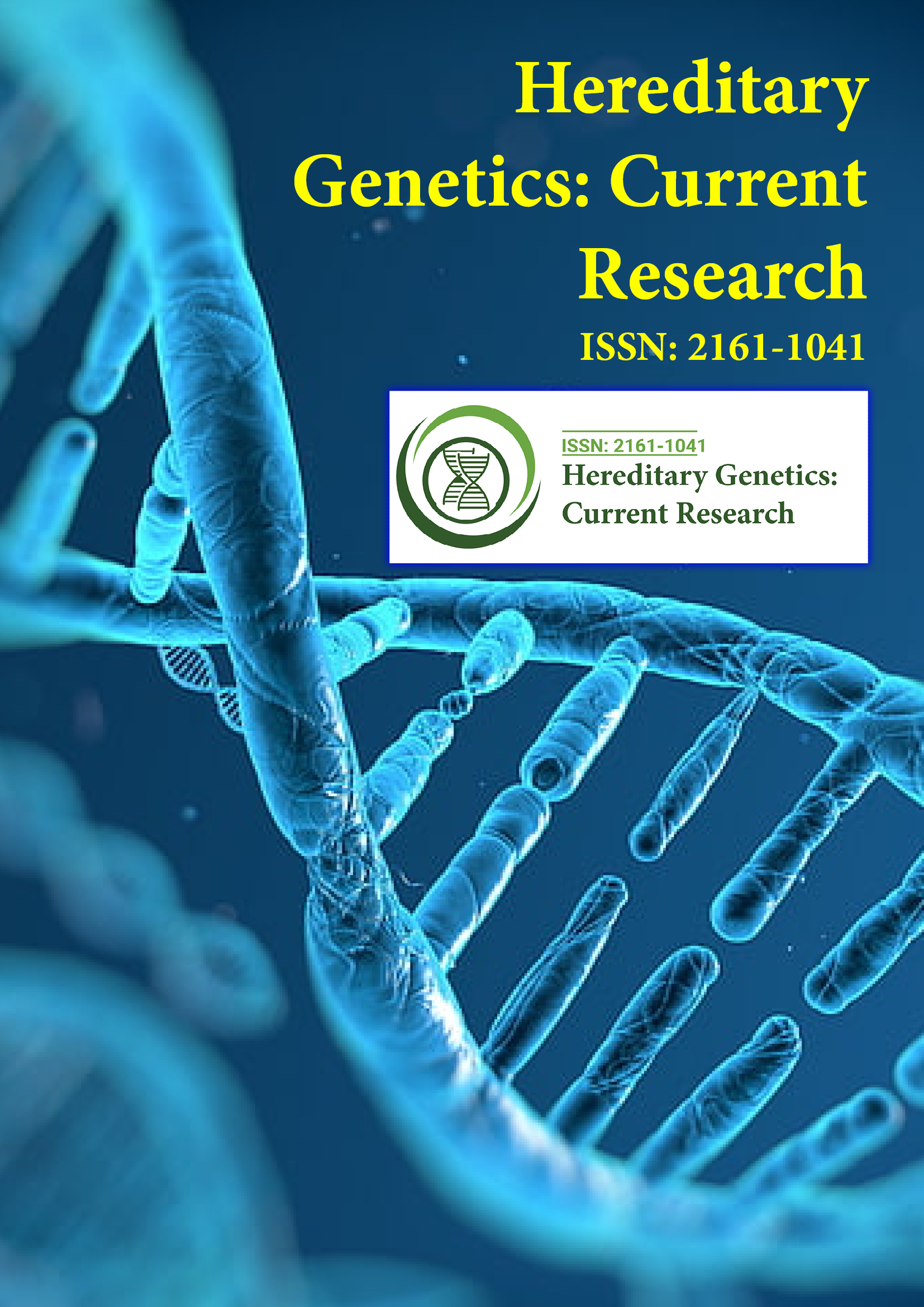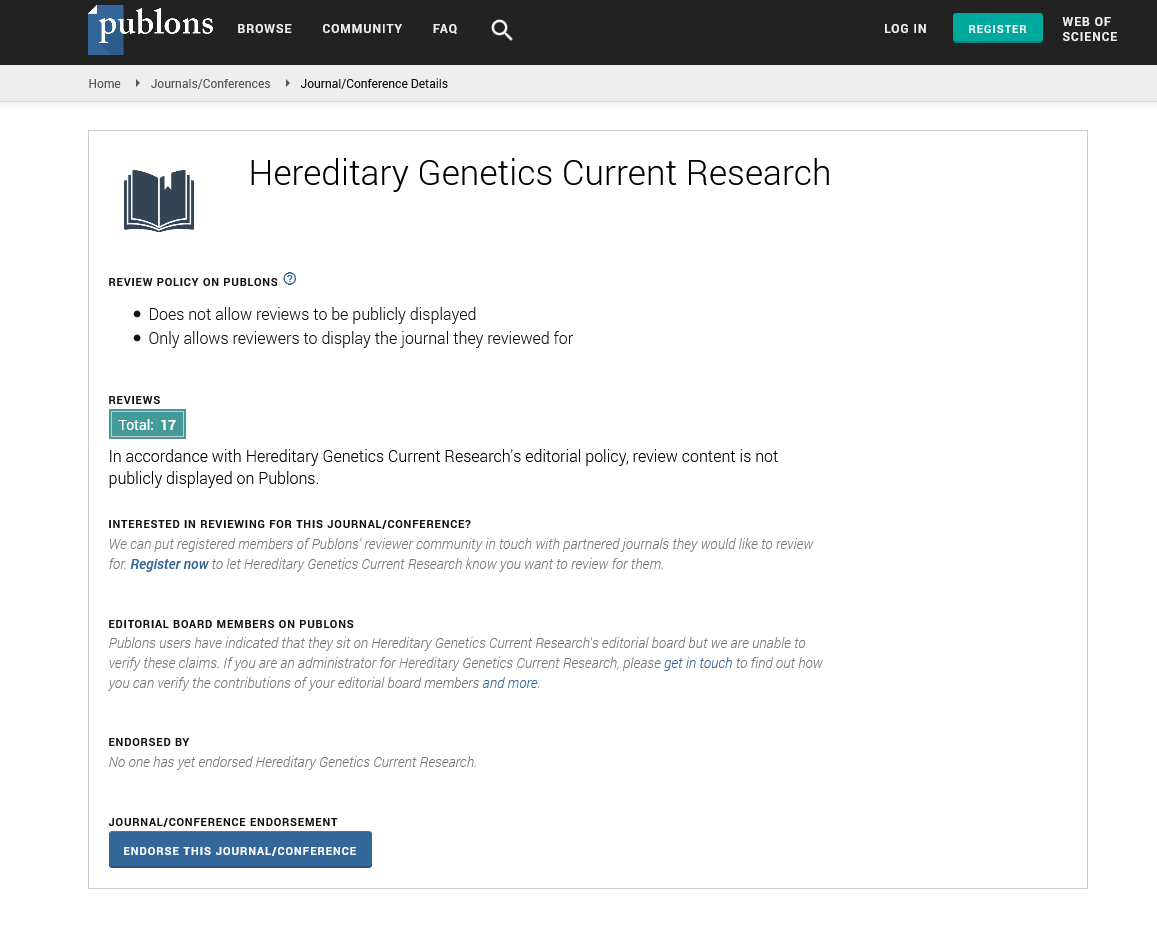Indexed In
- Open J Gate
- Genamics JournalSeek
- CiteFactor
- RefSeek
- Hamdard University
- EBSCO A-Z
- NSD - Norwegian Centre for Research Data
- OCLC- WorldCat
- Publons
- Geneva Foundation for Medical Education and Research
- Euro Pub
- Google Scholar
Useful Links
Share This Page
Journal Flyer

Open Access Journals
- Agri and Aquaculture
- Biochemistry
- Bioinformatics & Systems Biology
- Business & Management
- Chemistry
- Clinical Sciences
- Engineering
- Food & Nutrition
- General Science
- Genetics & Molecular Biology
- Immunology & Microbiology
- Medical Sciences
- Neuroscience & Psychology
- Nursing & Health Care
- Pharmaceutical Sciences
Perspective Article - (2024) Volume 13, Issue 2
Laboratory Methods in the Assessment of Hereditary Disorders: A Critical Evaluation
Flora Gallegos*Received: 28-May-2024, Manuscript No. HGCR-24-28367; Editor assigned: 31-May-2024, Pre QC No. HGCR-24-28367 (PQ); Reviewed: 14-Jun-2024, QC No. QC HGCR-24-28367; Revised: 21-Jun-2024, Manuscript No. HGCR-24-28367 (R); Published: 28-Jun-2024, DOI: 10.35248/2161-1041.24.13.285
Description
Hereditary disorders, also known as genetic diseases, arise from abnormalities in the genetic code passed down from parents to offspring. These conditions, which can affect various parts of the body and lead to lifelong health challenges, have long intrigued scientists, physicians and genetic counselors alike. The advent of laboratory diagnostic techniques has revolutionized our ability to understand, diagnose and manage these disorders. In the past few decades, significant advancements in laboratory methods have enhanced the accuracy, speed and accessibility of genetic testing, playing a major role in the early diagnosis, prognosis and personalized treatment of hereditary diseases.
In hereditary disorder diagnosis, PCR is particularly valuable for identifying point mutations, small insertions or deletions and specific genetic markers associated with diseases. For example, in cystic fibrosis, PCR can be used to detect mutations in the CFTR gene, which is responsible for the disorder. PCR is widely used because of its simplicity, high sensitivity and the relatively low cost of implementation.
However, while PCR is a powerful tool, it has its limitations. It can be less effective for detecting larger structural variations in genes, such as large deletions or duplications, which may not be amplified as efficiently. For these reasons, complementary methods are often employed.
Next-Generation Sequencing (NGS), also referred to as highthroughput sequencing, has revolutionized genetic testing by enabling the sequencing of multiple genes in parallel at a much higher throughput and lower cost than traditional methods. NGS can analyze entire exomes (the protein-coding regions of the genome) or even the whole genome, providing comprehensive insights into the genetic basis of hereditary diseases.
NGS has significantly enhanced the ability to detect a wide range of mutations, from single nucleotide changes to larger structural variations. It is particularly valuable for diagnosing complex genetic disorders with unknown or variable genetic causes. However, the interpretation of NGS results remains a challenge due to the vast amount of data generated and the need for advanced bioinformatics tools to filter through variants of uncertain significance.
CMA involves the hybridization of a patient's DNA to a microarray chip containing thousands of DNA probes representing different parts of the genome. This allows for the detection of Copy Number Variations (CNVs) across the genome. CNVs are changes in the number of copies of a particular region of the chromosome and they can play a major role in genetic diseases. The method has proven to be especially helpful in cases where traditional karyotyping or sequencing fails to provide a diagnosis.
While CMA offers a significant advantage in identifying large chromosomal alterations, it does not provide information about single nucleotide mutations, making it a complementary technique to PCR and sequencing. Additionally, the interpretation of CMA results can be complicated, as not all CNVs are pathogenic and many may be of unknown clinical significance.
Fluorescence In Situ Hybridization (FISH) can be used to identify specific mutations in hereditary disorders like Duchenne muscular dystrophy, where a deletion in the dystrophin gene can be detected using FISH. The advantages of FISH include its ability to visualize specific genetic sequences in real-time within the context of the entire chromosome, making it an excellent tool for structural variation detection.
However, FISH is typically limited to known genetic alterations and is less effective in identifying novel or previously uncharacterized mutations. It also requires specialized equipment and expertise.
Conclusion
The laboratory methods used in the assessment of hereditary disorders have undergone tremendous advancements in recent years. PCR, sequencing, CMA, FISH and gene panel testing have transformed our ability to diagnose and understand the genetic basis of these conditions. While each method has its strengths and weaknesses, the combination of these tools, often in a complementary approach, provides a powerful means of diagnosing hereditary diseases with increasing accuracy and efficiency.
Citation: Gallegos F (2024). Laboratory Methods in the Assessment of Hereditary Disorders. Hereditary Genet. 13:285.
Copyright: © 2024 Gallegos F. This is an open accessarticle distributed under the terms of the Creative Commons Attribution License, which permits unrestricted use, distribution, and reproduction in any medium, provided the original author and source are credited.

